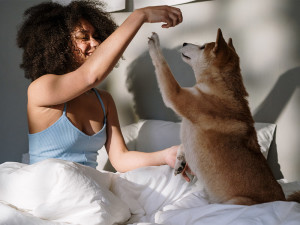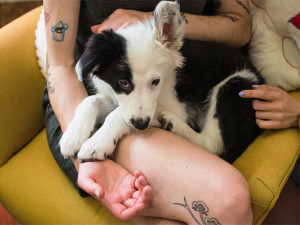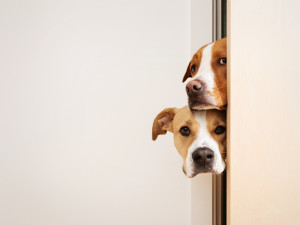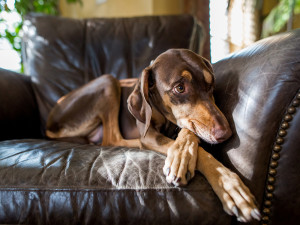Can Your Shy New Rescue Dog Become a Social Creature?
With patience and positive reinforcement, you can do a lot to make up for lost time with socialization.
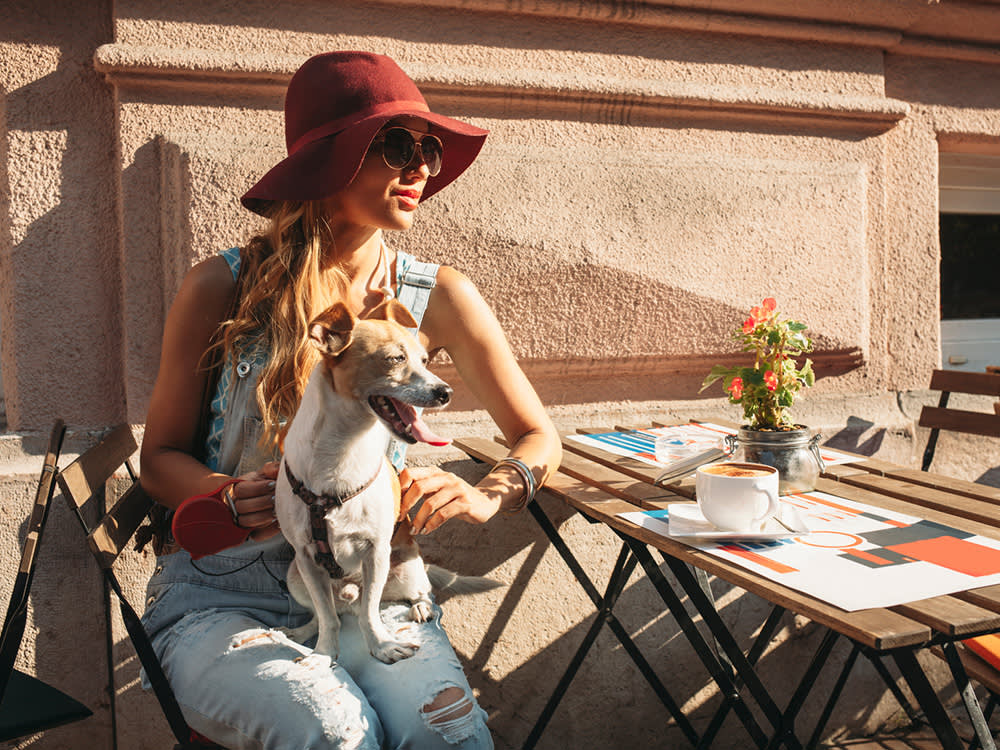
Share Article
So, how did those early puppy days go for you? Did your dog miss out on socialization during their critical early months? Maybe you were advised to keep your puppy isolated for health reasons, or your work schedule had you so swamped that nothing went according to plan, or you adopted an adult dogopens in a new tab who didn’t get off to the best start in life for who-knows-what-reason. No matter how your dog wound up with a socialization deficit, there’s a good chance you frantically Googled it and are now worried about your pup’s prospects for happiness.
But it’s actually not all gloom and doom. There are things you can do instead of throwing your hands up in despair. Here’s the intel on how to most effectively — and kindly — teach your dog that the world isn’t such a scary place.

littleKin™ is Kinship’s home just for puppy and kitten parents. Bop over to check out expert advice, new pet tools, and special deals—all curated for your newest family member.
opens in a new tabFirst, don’t panic.
Seriously, all is not lost. Sure, this isn’t the ideal situation, but your dog can still have a wonderfully fulfilling life. Tons of dogs who weren’t socialized “by the book,” experience joy every day, and so do their people. The key to making that a reality for dogs who have not had the benefit of proper socialization is the same as for almost all goals: work slowly and patiently. Rather than pushing your dog, accept that they will determine how fast you get where you want to go. Setting an arbitrary deadline for their progress is not helpful. There’s never been a circumstance better suited for the phrase, “It’s the journey, not the destination.”
Remember the purpose of socialization.
The aim is to expose your dog to a variety of objects, social partners, sounds, sights, and experiences in a positive and non-threatening way. During the early months of their lives (especially from three to 12 weeks, which technically represents the socialization stage of development), puppies are really good at accepting anything they encounter in a non-scary way. It’s super-easy during this critical period for dogs to get used to new things if the new things are connected to happy experiences. (“That man with the funny hat gives me treatsopens in a new tab!” Or, “This floor has a weird feeling, but it’s fun to play fetchopens in a new tab on it!”)
It’s generally harder for dogs to adjust to novelty after the socialization window has closed, though the better the socialization was, the easier it is for them to generalize. (“Oh, another peculiar hat — that’s cool.” Or, “Wow, this floor is different than the others — that’s fine.”) For adult dogs who did not have those good experiences early on, learning to accept new things and be comfortable in the world takes more effort, but progress can be made and can continue to be made throughout their lives.
It’s kind of like learning a language. It’s much easier for babies and young children than it is for adults — almost effortless with the right exposure. But adults can and do learn foreign languages all the time. The degree to which they master the language depends on their natural abilities and the time and effort they put in.
Keep experiences positive.
The most important part of making up for lost socialization opportunities is to keep it positive. Your dog can learn to accept novel situations and experiences or become less fearful of them by having many, many positive experiences.
For example, let’s say your dog didn’t meet children early in their life and now finds them terrifying. They can learn to be OK around children if you begin with a child who’s too far away to upset them. When they see a calm child down the block or on the other side of the park, give them a treat. Do that enough times, and your dog will start to associate the sight of a child with a reward. That makes seeing a child a positive experience, and that’s great.
Over time, you can gradually — and the operative word here is gradually — have your dog in situations with a child who is closer, or with multiple children, in ways that don’t upset them but instead, continue to teach your dog to be happy about seeing children. Those positive experiences are critical for success.
Conversely, you cannot help your dog become comfortable around children by exposing them to negative experiences — say, with a child a few feet away or a nearby gaggle of children running, screaming, and throwing their backpacks around. That’s too much for most dogs, well-socialized or not, and no number of treats can make it into a positive experience. Those negative experiences work against the goal of helping your dog be comfortable around kids by reinforcing the idea they already have about children being terrifying.
Go slowly and don’t rush your dog.
Helping your dog succeed takes many steps, and there is nothing to be gained by rushing through them. In fact, rushing your pup is counterproductive. Let them guide your timeline rather than the other way around. If they’re handling a situation well, great. If not, get your dog out of it. Accept that they are providing you with an opportunity to practice your own patience.
If you force them to be too close to something or spend too much time in a context in which they’re uncomfortable, you will only get in the way of their progress; you will not accelerate it. Any time you’re trying to help your dog overcome a fear or discomfort, you must be willing to retreat, even if you don’t want to.
Ideally, you can keep the situation positive and quit while you’re ahead, but if that fails, you must remove them. Protecting your dog from situations that cause your pup distress is a great kindness. Work with your dog where they are, exposing them to new things in ways that work for your pup without trying to expose them to the whole world at once.
Adjust your expectations.
If your adult dog missed out on puppy socialization, they’re taking a different route than they would have with the benefit of those early experiences. Don’t expect them to be a social butterfly who handles absolutely everything with the greatest of ease. Frankly, dogs with perfect socialization histories don’t often end up that way, and it’s even less likely for a dog who didn’t have such opportunities. Remember, the goal is a dog who is safe and happy, comfortable with most of the things and people they encounter in life. Your pup doesn’t have to be a happy-go-lucky dog without a care in the world to be incredibly fortunate and enjoy life to its fullest.
Don’t try to do this on your own.
There are many resources to help a dog who needs to learn to be comfortable and unafraid, including booksopens in a new tab, webinars, and websitesopens in a new tab. Make use of them. Many focus on helping fearful dogsopens in a new tab. That’s because most dogs who were not well-socialized are fearful of various aspects of the world, whether it’s cats, other dogs, people, carpeting, stairs, or the sound of cars.
Seek out individualized help. A qualified trainer or behaviorist can teach you how to use the principles of classical conditioning along with the best treats and toys to help your dog make positive associations between new things and feeling good. It may not be as quick as if they had had those exposures as a puppy, but they can still make them.
Take advantage of what they can already handle.
For example, many dogs have not been well-socialized with people but are very comfortable with other dogs. Take advantage of that and go new places with a dog buddy. If one isn’t already living in your house, perhaps you can borrow a dog, or a friend and their dog can come along on outings.
Or maybe they had what some would describe as “no socialization,” but that’s not actually accurate. Did they meet a couple of people? Hear high winds blowing or walk on grass as well as pavement? All of these exposures are helpful and make them very different from a dog who truly had no socialization at all. There are rare and heartbreaking examples of dogs who’ve had no human or canine interaction during the first six months of their lives. While these dogs are much more challenging to rehabilitate and are unlikely to make as much progress as most dogs, the principles are the same.
Remember that many dogs thrive even without ideal socialization experiences, and there’s always time to help your dog achieve many of the benefits of socialization. It’s essential to adjust your expectations based on the start they had in life, but that doesn’t mean you should give up on them. The effort requires patience, time, and a realistic setting of expectations. Go slowly, keep experiences positive, be diligent about helping your dog handle things that alarm them, and protect them from situations that could overwhelm them. Plenty of dogs who were not socialized in a textbook manner are filled with love and joy every day, and your dog can be one of them.

Karen B. London, PhD, CAAB, CPDT-KA
Karen B. London, Ph.D., is a Certified Applied Animal Behaviorist and Certified Professional Dog Trainer who specializes in working with dogs with serious behavioral issues, including aggression, and has also trained other animals including cats, birds, snakes, and insects. She writes the animal column for the Arizona Daily Sun and is an Adjunct Professor in the Department of Biological Sciences at Northern Arizona University. She is the author of six books about training and behavior, including her most recent, Treat Everyone Like a Dog: How a Dog Trainer’s World View Can Improve Your Lifeopens in a new tab.
Related articles
![Shy black dog walking with owner at the park.]() opens in a new tab
opens in a new tabHow to Help an Anxious Dog Conquer Their Fears
Pro tips for boosting the confidence of a scaredy-cat dog.
![Two fearful adolescent dogs peeking through a slightly open door]() opens in a new tab
opens in a new tabPuppy Fear Periods: Why is My Dog Scared All of a Sudden?
Turns out, adolescence isn’t just tough for humans—it can be hard on dogs, too.
![A shy looking dog sitting on a couch.]() opens in a new tab
opens in a new tabSome Dogs Are Scaredy Cats — And That’s OK
Not all fearful dogs have been mistreated.
![A woman sitting with her arm around a dog enjoying a view of water.]() opens in a new tab
opens in a new tabHow to Cure Your Dog’s Case of the Everyday Scaries
There’s nothing to fear but fear itself — and a dog who won’t stop shaking when it thunders.
![Dog trainer reinforcing good behavior with a young boxer dog on a dog training field]() opens in a new tab
opens in a new tabThese Reinforcement Techniques in Dog Training Will Make Rules Fun for Both of You
Offering fewer treats can actually be a good thing.
![Young blonde woman with a Jack Russell puppy during spring in the city.]() opens in a new tab
opens in a new tabThe Best Training Treats for Dogs in 2025
The most mouth-watering treats for training your pup.
